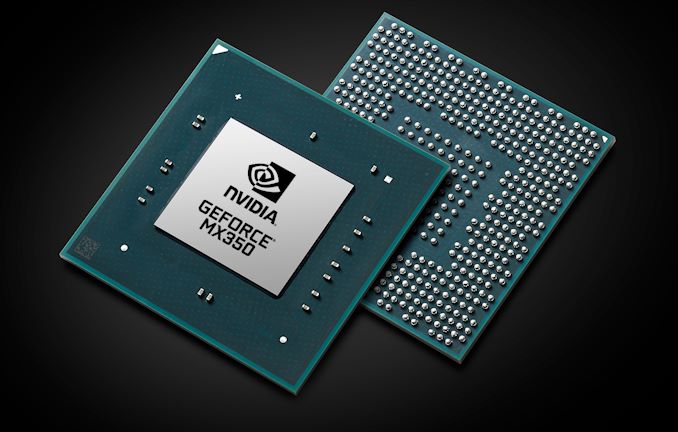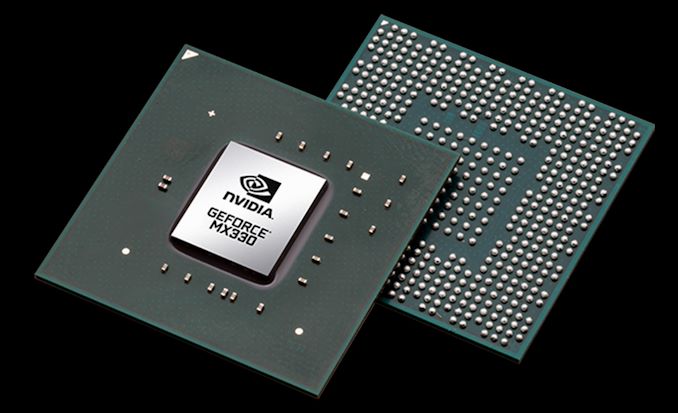NVIDIA Quietly Reveals GeForce MX350 & MX330: 2020's Entry-Level Laptop GeForce
by Ryan Smith on February 14, 2020 8:00 AM EST
For the better part of the past 5 years, NVIDIA has held an extremely solid grip on the market for discrete laptop GPUs. From the top to bottom, unless it’s a MacBook the odds are it’s powered by a GeForce. This is the case even at the very bottom of the discrete market, where next to the grues and the 4200 RPM hard drives, you’ll find NVIDIA’s series of discrete adapters for entry-level laptops. Designed to be the first step up above Intel’s integrated graphics, these parts do fill an important role in the market, but they don’t get much attention – even from NVIDIA.
At any rate, this week the company has updated those adapters for 2020 with the release of the Pascal-based GeForce MX350 and MX330.
As has become an annoying tradition for NVIDIA, they’re officially saying very little about the new parts. The official specifications don’t include anything about clockspeeds, CUDA core counts, ROPs, etc. Instead, NVIDIA only confirms a basic set of features: both parts use GDDR5 memory, both feature GPU boost functionality, and both support DirectX12 up to feature level 12_1. Past that you won’t get much else from NVIDIA; even the architecture isn’t officially published in their spec sheets, though in this case we can make a very reasonable assumption that it’s once again Pascal.
Meanwhile, NVIDIA has once again moved up their Intel reference point; for the MX300 series, it’s now Intel’s 64EU Gen11 Iris Plus iGPU found in the Core i7-1065G7. This is Intel’s fastest iGPU for their 15W U-series parts, and is reasonably potent on its own, so it helps to inform what kind of performance NVIDIA needs to hit to offer something that’s a meaningful step up.
| NVIDIA Laptop Video Adapter Specification Comparison | ||||
| Typical MX350 | Typical MX330 | |||
| CUDA Cores | 640 | 384 | ||
| ROPs | 16? | 16? | ||
| Memory Type | GDDR5 | GDDR5 | ||
| Memory Bus Width | 64-bit | 64-bit | ||
| VRAM | <=4GB | <=2GB | ||
| GPU | GP107 | GP108 | ||
| Manufacturing Process | Samsung 14nm | Samsung 14nm | ||
| Launch Date | 02/12/2020 | 02/12/2020 | ||
At any rate, while NVIDIA doesn’t publish much in the way of specifications, this year NotebookCheck claims to have the specifications for the parts. We haven’t been able to independently validate these figures, but they are quite reasonable, and very close to what I was expecting anyhow based on NVIDIA’s loose performance claims. In particular, these are both low-end Pascal-based parts, which remain NVIDIA’s smallest (and thus cheapest to produce) GPUs among their current Pascal and Turing product stacks.
Coming from last year’s MX200 series parts, the big change here is at the top. With Intel’s baseline going up, so does NVIDIA’s performance; and as a result NVIDIA has tapped a more powerful GPU than in past years. For the MX350 then, we’re looking at a GP107 GPU, a notably more powerful part than NVIDIA’s normal entry-level parts. Essentially a further cut-down GTX 1050, according to NotebookCheck this part has 640 CUDA cores enabled, as well as half of its usual ROP/memory controller partitions, leaving 16 ROPs and a 64-bit memory bus.
Meanwhile the MX330 is the more traditional GP108 showing. At a high level, take last year’s MX250, tweak the clockspeeds a bit, and you have an MX330. Which means 384 CUDA cores paired with 16 ROPs and a 64-bit memory bus.
Like past MX-series parts, NotebookCheck notes that both the MX350 and MX330 are informally rated for TDPs of 25W. However laptop manufacturers can and will adjust TDPs and clockspeeds to meet the specific power/cooling limitations of their notebooks, so like other laptop discrete graphics implementations, expect to see performance vary from design to design.
Based on NVIDIA's previous release cadences for their low-end laptop parts, expect to see these new processors show up in laptops in the very near future. Traditionally these parts are paired with Intel U-series processors, and I expect to see the same here.
Source: NVIDIA & NotebookCheck











16 Comments
View All Comments
jimjamjamie - Friday, February 14, 2020 - link
Shame we are not getting Turing but still good enough to fight off Intel I suppose.P.s.- First.
PeachNCream - Friday, February 14, 2020 - link
"...Intel’s 64EU Gen11 Iris Plus iGPU..."Not even sure the bar is actually that high given how uncommon Intel's faster GPUs have been in the past.
ksec - Friday, February 14, 2020 - link
Is this the first Samsung 14nm from Nvidia?FullmetalTitan - Friday, February 14, 2020 - link
First and only so farRyan Smith - Friday, February 14, 2020 - link
Note that GP107 and GP108 were released back in 2016. So this isn't new by any means.ksec - Saturday, February 15, 2020 - link
Well then this is big news. At least we know Nvidia is seriously testing Samsung Foundry with a shipping product. It also has the volume that Samsung Foundry desperately need.s.yu - Monday, February 17, 2020 - link
I was wondering if they were saving all the GP107 that didn't pass QC all these years to shut down defective cores and rebrand them now as MX350, at least this answers me that they're newly manufactured :)Spunjji - Thursday, February 20, 2020 - link
I think there's some confusion here. The MX350 is the same GP107 that has been around since 2016 - so this rebrand is likely either using accumulated defective dies, or unsold 1050 stock with parts fused off. Given the small size of the die and the maturity of the manufacturing process, I'd guess it's more of the latter.Spunjji - Thursday, February 20, 2020 - link
It's not really news though - or rather, it was 2016's news.qlum - Friday, February 14, 2020 - link
I really wish the low end desktop cards get a refresh sometime. Running especially ryzen on pc's that dont need a strong gpu but do benifit from more cores or simply setups with more then 3 monitors